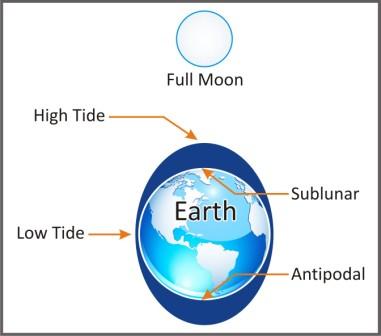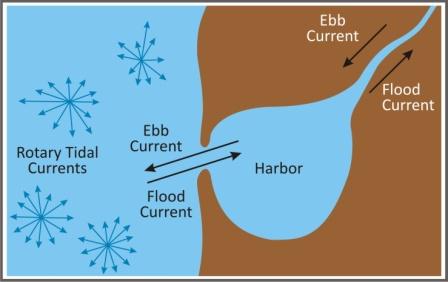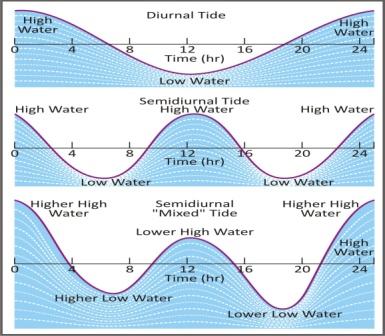What is meant by tide and ebb? |
|
The periodic variation in the surface level of the oceans and of bays, gulfs, inlets, and estuaries, caused by gravitational attraction of the moon and sun is called tide.
|
|
A period of decline or diminution is called ebb.
|
 |
What causes the formation of tide? |
|
Major reason of the tides is the gravitational pull produced on the surface of earth by the Moon and the sun.
|
|
As the Earth rotates, it is tugged at by the Moon and Sun.
|
|
Because the Moon is much closer, the pull of the Moon is approximately twice as strong as the pull of the Sun, which explains why the tides are so closely linked with the lunar day.
|
 |
|
Tides are caused by the gravitational pull of the Sun and Moon on the Earth's surface.
|
|
While most people associate tides specifically with the ocean, the entire planet is subject to tidal forces, as is the atmosphere, and in fact all celestial bodies are influenced by tidal forces.
|
|
The large volume of water on the Earth has made the actions of the tides particularly notable and interesting.
|
Watch this Video ! |
High tide and low tide |
|
High tide is when the moon pulls the water up further onto the beach creating less sand space.
|
|
Low tide is when the moon pulls the sea out further creating more sand space.
|
 |
Different types of tides |
|
Spring tide
|
|
Neap tide
|
|
Mixed tide
|
|
Bay tide
|
|
Lunar tide
|
 |
|
When the moon is full or new, the gravitational pull of the moon and sun are combined.
|
|
At these times, the high tides are very high and the low tides are very low. This is known as a spring high tide.
|
|
Spring tides are especially strong tides (they do not have anything to do with the Spring season). They occur when the Earth, the Sun, and the Moon are in a line.
|
|
The gravitational forces of the Moon and the Sun both contribute to the tides.
|
|
Spring tides occur during the full moon and the new moon.
|
 |
|
During the moon's quarter phases the sun and moon work at right angles, causing the bulges to cancel each other.
|
|
The result is a smaller difference between high and low tides and is known as a neap tide.
|
|
Neap tides are especially weak tides.
|
|
They occur when the gravitational forces of the Moon and the Sun are perpendicular to one another (with respect to the Earth).
|
|
Neap tides occur during quarter moons.
|
 |
 |
|
Tides vary in frequency. In some locations, tides are diurnal, meaning that there is one high tide and one low tide every day.
|
|
In other areas, tides are semidiurnal, with two high and two low points.
|
|
By observing tidal patterns in an area and keeping track of the movements of the Earth, Moon, and Sun, it is possible to create tide charts, predictions which list the time and height of various tides.
|
|
Tide charts are extremely important for navigation, especially in areas with extreme tidal ranges.
|
 |
Tidal flows |
|
Freshwater inflows fluctuate in a more-or-less random fashion in response to surface runoff from tributary catchments.
|
|
The construction of major dams in upstream catchment areas reduces both the volumes of freshwater runoff and the freshwater flushing of estuaries.
|
|
In times of drought, freshwater inflows may be absent, or may consist principally of the constant discharge of sewage effluent and other wastewaters.
|
|
Tidal flows are followed by five steps:
|
|
(a) Ebb and flood tides
|
|
The vertical rise and fall of the tide produces horizontal flows in the form of tidal currents.
|
|
Depending on the tidal range, entrance characteristics and the depth of the estuary, tidal currents can have quite fast velocities (up to 1.0 m/s).
|
|
The incoming or rising tide is traditionally referred to as the flood tide because it floods the channel.
|
|
The outgoing tide is referred to as the ebb tide.
|
|
The strength of the ebb and flood tide velocities varies diurnally and over Spring Neap cycles in exactly the same way as tidal water levels vary (Spring Tides produce the fastest tidal currents).
|
|
|
|
(b) Slack water:
|
|
The period of quiet water when the tide reverses from flood to ebb or vice versa is referred to as slack water.
|
|
|
|
(c) Phase lag:
|
|
Depending upon the type of estuary, the peak tidal discharge often occurs at different times to local high and low waters at the same location. This difference is referred to as phase lag.
|
|
|
|
(d) Tidal excursion:
|
|
The total distance travelled by a water particle from low water slack to high water slack and vice versa is referred to as the tidal excursion.
|
|
Typical tidal excursions in the tidal rivers of New South Wales are of the order of 5 km and vary from tide to tide.
|
|
This represents the maximum distance travelled by a water particle during the rising or falling limb of the tide.
|
|
|
|
(e) Tidal prism:
|
|
The total volume of water moving past a fixed cross section of the estuary during each flood tide or ebb tide (i.e. slack water to slack water) is referred to as the tidal prism.
|
 |
Let Us Share |
|
Tides at Halls Harbour on Nova Scotia's Bay of Fundy
|
|
Mumbai's highest tide in 100 yrs
|
 |
 |